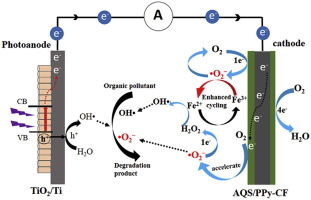当前位置:
X-MOL 学术
›
Water Res.
›
论文详情
Our official English website, www.x-mol.net, welcomes your
feedback! (Note: you will need to create a separate account there.)
Dramatic enhancement of organics degradation and electricity generation via strengthening superoxide radical by using a novel 3D AQS/PPy-GF cathode
Water Research ( IF 11.4 ) Pub Date : 2017-08-24 , DOI: 10.1016/j.watres.2017.08.054 Yan Zhang , Jinhua Li , Jing Bai , Linsen Li , Ligang Xia , Shuai Chen , Baoxue Zhou
Water Research ( IF 11.4 ) Pub Date : 2017-08-24 , DOI: 10.1016/j.watres.2017.08.054 Yan Zhang , Jinhua Li , Jing Bai , Linsen Li , Ligang Xia , Shuai Chen , Baoxue Zhou

|
A dramatic enhancement of organics degradation and electricity generation has been achieved in a wastewater fuel cell (WFC) system via strengthening superoxide radical with radical chain reaction by using a novel 3D anthraquinone/polypyrrole modified graphite felt (AQS/PPy-GF) cathode. The AQS/PPy-GF was synthesized by one-pot electrochemical polymerization method and used to in-situ generate superoxide radical by reducing oxygen under self-imposed electric field. Results showed that methyl orange (MO) were effectively degraded in AQS/PPy-GF/Fe2+ system with a high apparent rate constant (0.0677 min−1), which was 3.9 times that (0.0174 min−1) in the Pt/Fe2+ system and even 9.4 times that (0.0072 min−1) in the traditional WFC system (without Fe2+). Meanwhile, it showed a superior performance for electricity generation and the maximum power density output (1.130 mW cm−2) was nearly 3.3 times and 5.0 times higher, respectively, when compared with the Pt/Fe2+ system and traditional WFC. This dramatic advance was attributed to 3D AQS/PPy-GF cathode which produces more O2− via one-electron reduction process. The presence of  O2− cannot only directly contribute to MO degradation, but also promotes the final complete mineralization by turning itself to OH
O2− cannot only directly contribute to MO degradation, but also promotes the final complete mineralization by turning itself to OH . Additionally,
. Additionally,  O2− accelerates the Fe2+/Fe3+ couple cycling, thus avoiding continuous addition of any external ferrous ions. Inhibition and probe studies were conducted to ascertain the role of several radicals (
O2− accelerates the Fe2+/Fe3+ couple cycling, thus avoiding continuous addition of any external ferrous ions. Inhibition and probe studies were conducted to ascertain the role of several radicals ( OH and
OH and  O2−) on the MO degradation. Superoxide radicals were considered as the primary reactive oxidants, and the degradation mechanism of MO was proposed. The proposed WFC system provides a more economical and efficient way for energy recovery and wastewater treatment.
O2−) on the MO degradation. Superoxide radicals were considered as the primary reactive oxidants, and the degradation mechanism of MO was proposed. The proposed WFC system provides a more economical and efficient way for energy recovery and wastewater treatment.
中文翻译:

通过使用新型3D AQS / PPy-GF阴极增强超氧自由基来显着增强有机物的降解和发电
通过使用新型3D蒽醌/聚吡咯改性石墨毡(AQS / PPy-GF)阴极通过自由基链反应增强超氧自由基,可以在废水燃料电池(WFC)系统中实现有机物降解和发电的显着提高。AQS / PPy-GF是通过一锅电化学聚合法合成的,用于在自加电场下通过还原氧原位生成超氧自由基。结果表明,甲基橙(MO)在AQS / PPy-GF / Fe 2+系统中被有效降解,具有较高的表观速率常数(0.0677 min -1),是Pt /中的(0.0174 min -1)的3.9倍。Fe 2+系统甚至是其的9.4倍(0.0072 min -1)在传统的WFC系统中(不含Fe 2+)。同时,其表现出优异的发电性能,与Pt / Fe 2+系统和传统WFC相比,最大功率密度输出(1.130 mW cm -2)分别高出近3.3倍和5.0倍。这一显着进步归功于3D AQS / PPy-GF阴极,该阴极可产生更多ö 2 -通过单电子还原过程。存在的 Ø 2 -不仅可以直接促进MO退化,而且还通过转动自己OH促进最终完全矿化
Ø 2 -不仅可以直接促进MO退化,而且还通过转动自己OH促进最终完全矿化 。此外,
。此外, ö 2 -加速的Fe 2+ / Fe的3+的夫妇循环,从而避免了连续添加任何外部亚铁离子。进行了抑制和探针研究,以确定几种自由基的作用(
ö 2 -加速的Fe 2+ / Fe的3+的夫妇循环,从而避免了连续添加任何外部亚铁离子。进行了抑制和探针研究,以确定几种自由基的作用( OH和
OH和  Ø 2 - )的MO降解。超氧自由基被认为是主要的反应性氧化剂,并提出了MO的降解机理。拟议中的WFC系统为能源回收和废水处理提供了一种更加经济有效的方式。
Ø 2 - )的MO降解。超氧自由基被认为是主要的反应性氧化剂,并提出了MO的降解机理。拟议中的WFC系统为能源回收和废水处理提供了一种更加经济有效的方式。
更新日期:2017-08-25
 O2− cannot only directly contribute to MO degradation, but also promotes the final complete mineralization by turning itself to OH
O2− cannot only directly contribute to MO degradation, but also promotes the final complete mineralization by turning itself to OH . Additionally,
. Additionally,  O2− accelerates the Fe2+/Fe3+ couple cycling, thus avoiding continuous addition of any external ferrous ions. Inhibition and probe studies were conducted to ascertain the role of several radicals (
O2− accelerates the Fe2+/Fe3+ couple cycling, thus avoiding continuous addition of any external ferrous ions. Inhibition and probe studies were conducted to ascertain the role of several radicals ( OH and
OH and  O2−) on the MO degradation. Superoxide radicals were considered as the primary reactive oxidants, and the degradation mechanism of MO was proposed. The proposed WFC system provides a more economical and efficient way for energy recovery and wastewater treatment.
O2−) on the MO degradation. Superoxide radicals were considered as the primary reactive oxidants, and the degradation mechanism of MO was proposed. The proposed WFC system provides a more economical and efficient way for energy recovery and wastewater treatment.
中文翻译:

通过使用新型3D AQS / PPy-GF阴极增强超氧自由基来显着增强有机物的降解和发电
通过使用新型3D蒽醌/聚吡咯改性石墨毡(AQS / PPy-GF)阴极通过自由基链反应增强超氧自由基,可以在废水燃料电池(WFC)系统中实现有机物降解和发电的显着提高。AQS / PPy-GF是通过一锅电化学聚合法合成的,用于在自加电场下通过还原氧原位生成超氧自由基。结果表明,甲基橙(MO)在AQS / PPy-GF / Fe 2+系统中被有效降解,具有较高的表观速率常数(0.0677 min -1),是Pt /中的(0.0174 min -1)的3.9倍。Fe 2+系统甚至是其的9.4倍(0.0072 min -1)在传统的WFC系统中(不含Fe 2+)。同时,其表现出优异的发电性能,与Pt / Fe 2+系统和传统WFC相比,最大功率密度输出(1.130 mW cm -2)分别高出近3.3倍和5.0倍。这一显着进步归功于3D AQS / PPy-GF阴极,该阴极可产生更多ö 2 -通过单电子还原过程。存在的
 Ø 2 -不仅可以直接促进MO退化,而且还通过转动自己OH促进最终完全矿化
Ø 2 -不仅可以直接促进MO退化,而且还通过转动自己OH促进最终完全矿化 。此外,
。此外, ö 2 -加速的Fe 2+ / Fe的3+的夫妇循环,从而避免了连续添加任何外部亚铁离子。进行了抑制和探针研究,以确定几种自由基的作用(
ö 2 -加速的Fe 2+ / Fe的3+的夫妇循环,从而避免了连续添加任何外部亚铁离子。进行了抑制和探针研究,以确定几种自由基的作用( OH和
OH和  Ø 2 - )的MO降解。超氧自由基被认为是主要的反应性氧化剂,并提出了MO的降解机理。拟议中的WFC系统为能源回收和废水处理提供了一种更加经济有效的方式。
Ø 2 - )的MO降解。超氧自由基被认为是主要的反应性氧化剂,并提出了MO的降解机理。拟议中的WFC系统为能源回收和废水处理提供了一种更加经济有效的方式。











































 京公网安备 11010802027423号
京公网安备 11010802027423号